Lucio Fontana was an Italian painter, sculptor and theorist, born in Argentine. He is the founder of Spatialism.
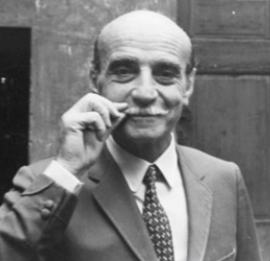
Image source: https://restelliartco.com/en/artists/artworks-modern-post-war-art/lucio-fontana-en/
Biography
Lucio Fontana was born in Rosario de Santa Fé in Argentina and raised in Milan. He moved back to Argentina in 1922 where he worked as a sculptor in his father’s studio. In 1926, he participated in the first exhibition of Nexus, a group of young local Argentinian artists. Returning to Milan in 1928, Fontana enrolled at the Accademia di Belle Arti of Brera. In 1935 he traveled to Paris and joined the Abstraction-Création group. In 1939, he joined Corrente, a Milan-based group of expressionist artists, while intensifying his collaborations with architects. In 1940, he came back to Buenos Aires, where he founded the “Academia de Altamira” with some of his students in 1946, from which the Manifiesto Blanco group emerged. He returned to Milan in 1947 and signed the First Manifest of Spatialism with a group of writers and philosophers. His first major international retrospective was held at the Solomon R. Guggenheim Museum in 1977. He died in 1968 at Comabbio after moving there from Milan.
What are the characteristics of his works?
Fontana repudiated the illusory space of traditional easel painting and sought to unite art and science to project colour and form into real space by the use of up-to-date techniques such as neon lighting and television. These forces will find the final rein in the revolutionary gesture of Fontana, who puncturing and cutting the surface of the painting, made the final step of detachment from the “old” art to the new space art.
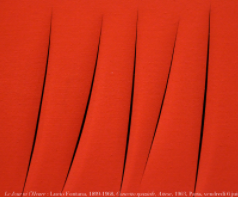
Image source: https://search.creativecommons.org/photos/48c5d773-0033-468d-b95c-3731af8880f9 by Renaud Camus
- As a sculptor, he experimented with stone, metals, ceramics, and neon. A sculptor trained in classical techniques, he made innovative sculptures produced for trade fairs and exhibitions promoting the ideology of Fascism in Italy.
- As a painter he attempted to transcend the confines of the two-dimensional plane. He argued that the surface of a canvas was as real, weird and wonderful as anything you could add to it.
He also wrote of the virtues of projecting colour and form into real spaces and using multi-media techniques such as neon lighting and television.

Image source: https://search.creativecommons.org/photos/73a2830a-21c5-44de-b165-b4c7ebe0a79a by HeinzDS
With the act of cutting a thinly painted monochromatic canvas with a sharp knife, Fontana changed the definition of art. This act challenged the entire history of Western easel painting and led him to the understanding that painting was no longer about illusion contained within the dimensions of a canvas but, rather, a dynamic concept that blended form, color, architectural space, gesture, and light.
Fontana’s works
After his return in Italy from Argentina in 1947, Fontana found his studio and works completely destroyed in the Allied bombings of Milan. Fontana entitled his works Spatial Concepts, among which a progression of categories unfolds, predicated on the fertile dichotomy between the hole and cut.
- This first environment was made in 1949, when Fontana introduced the Holes, in which he punctured the surface of the canvas in order to access the physical space and with it the metaphysical dimension behind the picture.
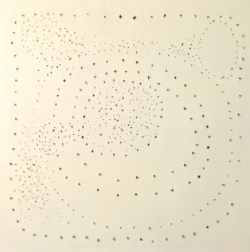
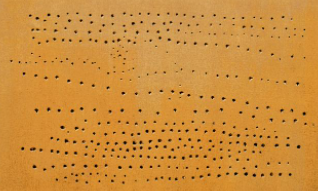
Images source: https://www.ngv.vic.gov.au/essay/no-form-can-be-spatial-the-origins-of-lucio-fontanas-spatial-concept-2/
- Fontana’s second environment Spatial light (1951) is an elaborate, looping neon sculpture originally designed for the ceiling of the Triennale di Milano.
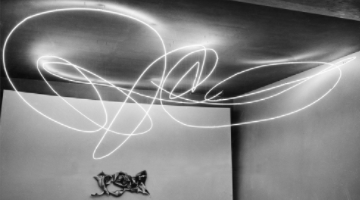
Image source: https://dailyartfair.com/artist/lucio-fontana
- In 1958, he began making Waiting, monochrome surfaces that he sliced open with a single gesture or inscribed with multiple cuts at irregular intervals across the canvas, exposing backgrounds that had been artfully darkened with black gauze to create a mysterious sense of illusion and depth.
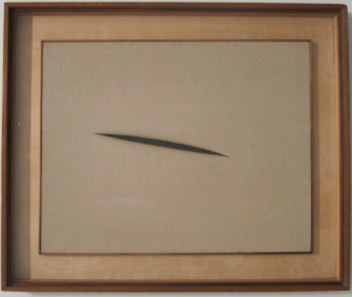
Image source: https://search.creativecommons.org/photos/efaf2f03-3e3e-4f86-a679-c523e65fd9d0 by Wmpearl
- He also created his first environmental work, Spatial Environment in Black Light, which consisted of a small black room in which several large, fossil-like forms made from papier maché hovered overhead, their fluorescent painted surfaces picked out by black light.
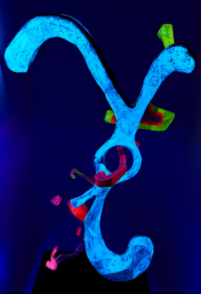
Image source: https://dailyartfair.com/artist/lucio-fontana
- The series End of God between 1963 and 64, several key examples of which have been brought together for the exhibition, all of Fontana’s concerns seem to coalesce in perfect resolution. These works, with their punctured, blasted, gouged, and lacerated surfaces, were his literal response to the anticipation of man’s first flight into outer space. They present a vision very different from his earlier optimism of a new spatial era driven by new scientific knowledge.
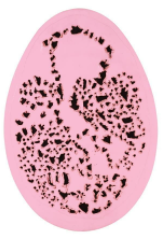
Image source: https://thunderstruck9.tumblr.com/post/143290535521/lucio-fontana-italian-1899-1968-concetto
- Trinity (1966) consists of three large white canvases punctuated by lines of hole, it is presented for the first time in the way that Fontana conceived it, embraced in a theatrical setting made from ultramarine plastic sheets vaguely resembling wings.

Info source:
https://www.gagosian.com/exhibitions/lucio-fontana–may-03-2012
